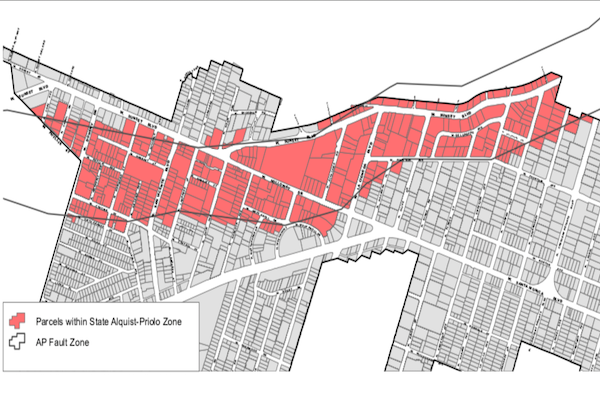
With a unanimous vote on Thursday night, West Hollywood’s Planning Commission approved changes to the city’s zoning ordinances to comply with new state regulations regarding accessory dwelling units, sometimes referred to as “granny flats.” The Commission also approved updates to the city’s earthquake faultline zone map to bring it into compliance with state law.
The zoning ordinance changes are to bring the city into compliance with state laws intended to override local restrictions on construction of new housing that have contributed to California’s housing crisis. The state now ranks 49th in the nation in construction of new housing units per resident, with the shortage of housing being a major contributor to soaring housing costs. Utah is the only state in the nation that has built less housing than necessary for its residents.
The item before the Planning Commission addressed changes required by AB 881, a bill introduced by Assembly Member Richard Bloom and signed by Gov. Gavin Newsom in September. AB 881 is one of a number of bills passed by the state legislature to address California’s housing crisis by over-riding restrictive city laws.
Accessory dwelling units (ADUs) are typically thought of as a garage that’s been converted into an apartment, but they can also be independent units attached to the main house. ADUs must have separate kitchens, bathrooms and exterior entrances.
Junior accessory dwelling units (JADUs) can be units carved out of an existing unit, but must have separate kitchen areas. However, they may have shared bathrooms and entrances within a main unit.
Current city law says ADUs are only allowed on single-family residential lots in residential zones. Under the new law, ADUs can now be a part of multi-family buildings and can be in any zone that allows residential units, including commercial zones where mixed-use (commercial and residential) is allowed.
Current city law says JADUs are only allowed on single-family residential lots, and that will not change with the new law.
The new law also says that an ADU cannot exceed 50% of the size of the primary dwelling unit, or a maximum of 1,200 square feet. For JADUs, the maximum size is 500 square feet.
The new state law effectively overrides existing city regulations about the number of units allowed in multi-unit buildings. It says that even if a building’s maximum Floor Area Ratio (FAR) standard is already met, the building can still add an ADU of up to 800 square feet. For example, if a building’s maximum FAR allows for eight units, an ADU could still be added for a total of nine units.
In multi-family buildings, a maximum of 25% of the units could be ADUs. However, the commission noted that some older buildings have large lobbies and property owners could now carve off a portion of that lobby to create an ADU.
The greatest potential change in the law regards parking. Current city law says that if a garage is converted to an ADU, then the owner must replace the parking space lost by creation of that unit. Under the new law, the owners do not have to replace the parking.
Commissioner Lynn Hoopingarner saw this as a loophole an owner might take advantage of. For example, an owner of a multi-unit building could take several spaces in a parking garage and create a new ADU. With the new law, the building owner would not have to replace those parking spaces, thus forcing the tenants who lost their parking spaces to the new ADU to park on the street. In areas where street parking is already tight, such as the Center City area, this could have a huge impact. Or as resident Steve Martin observed during the public comment period, it could be “essentially evicting” a resident by taking away his parking.
Commissioner Adam Bass also expressed concern about the state law’s impact on parking. He noted the state law allows for residents living in an ADU to apply for street parking permits even when a building has been conditioned not to allow its residents to get street parking permits.
Current law says ADUs must be architecturally compatible with the primary unit, but under the new law, they no longer have to be compatible because state law now forbids subjective terms like compatibility. Thus, the main house could be Spanish Revival style while the ADU could be English Tudor.
With state law AB881 regarding ADUs and JADUs taking effect on January 1, the Commission had no choice but to approve these changes. If it hadn’t the city’s existing laws regarding ADUs would be nullified. The City Council will consider these changes in December.
The Commission recommended that City Hall staff come back with follow-up regulations to try to address some of the issues that it had raised. Commissioners John Altschul and Sue Buckner were both absent.
Earthquake Fault Zones

The Planning Commission also unanimously approved updates to the city’s earthquake fault zone map, a change made to comply with state law.
The state recently updated its Alquist-Priolo Earthquake Fault Zone maps to reflect revised information regarding fault zones. In West Hollywood, the 9.3-mile Hollywood Fault runs just south of Sunset Boulevard and continues through Hollywood, Los Feliz, and Silver Lake into Atwater Village.
The city has long recognized the potential for damage along the Hollywood Fault and has guidelines for new developments along this zone. Fault Precaution Zone 1 (FP1) includes lots very likely to be above an active fault, while Fault Precaution Zone 2 (FP2) includes lots adjacent to FP1 that are less likely to contain an active fault.
Developers proposing to build within FP1 must conduct extensive, and expensive, site-specific geological fault rupture investigations to determine if there has been any earthquake activity on the lot in the last 11,000 years.
Those wanting to build in FP2 can either conduct the fault rupture investigation or enhance the building’s foundation. Most developers in this FP2 area simply choose to enhance the foundation since that is less expensive.
Under the revised map, many of the lots that were within the FP2 zone have been moved to the FP1 zone, while many lots have that were originally outside of the earthquake fault zone have been added to the FP2 zone, which is considered a buffer zone.
Commissioner Lynn Hoopingarner criticized the new map because the FP2 zone on the west side of the city has barely expanded. Most of the new FP2 buffer zone lots are in the Center City section.
Commissioner Rogerio Carvalheiro argued that buffer zones were not needed because data about exactly where the fault zones lie will come out as geological surveys are conducted and that information will then be added to the city’s fault zone maps.
With these approved revisions, the city will also make the earthquake fault zone map more accessible to the public. Currently, the map is included in a technical appendix in the back of the city’s General Plan. Now it will be moved to a more prominent placement within the safety section of the General Plan.
The commissioners praised city staff members for being proactive in making the earthquake zone map easier to find in the General Plan.
Commissioners Lynn Hoopingarner and Adam Bass suggested that from now on city staff reports should include a short section stating where a property is located in the earthquake fault zone. That way, developers and the public will both know where potential developments are located from the outset.
During the public comment period, resident Kevin Burton suggested creating a map that incorporates both the earthquake fault zone as well as the locations of apartment buildings that are required to do seismic retrofitting to protect against potential collapse during an earthquake. That would provide potential renters with greater information when choosing apartments.

Thanks James Mills for interesting share! the sound is great!